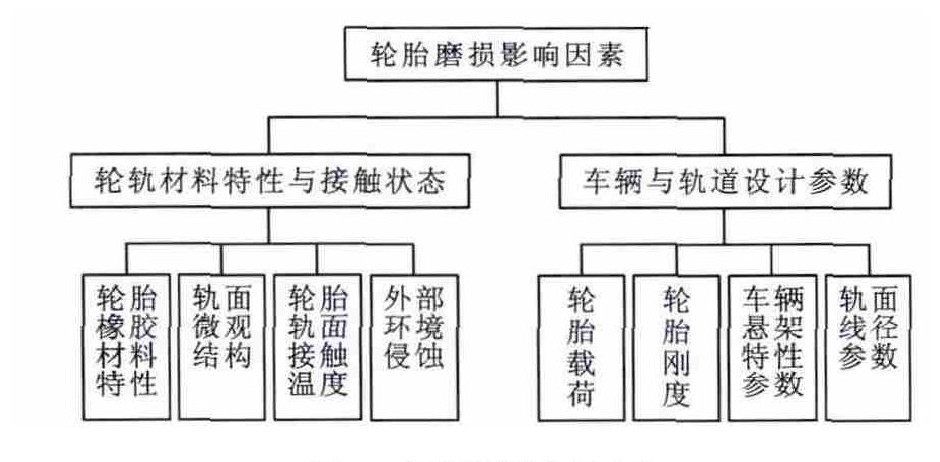Influence of cornering stiffness of straddle-type monorail running wheel on tire wear under curve negotiating
-
摘要: 基于车辆轮胎磨损理论, 研究了走行轮侧偏刚度对走行轮侧偏力和导向轮、稳定轮径向力的影响, 分析了单轨车辆曲线运行时, 走行轮摩擦功随轮胎侧偏刚度的变化趋势。分析结果表明: 受导向轮、稳定轮径向力影响, 随着走行轮侧偏刚度增加, 走行轮侧偏力逐渐增大; 当走行轮侧偏刚度处于1120kN·rad-1范围时, 走行轮侧偏力与侧偏角处于线性范围, 侧偏角呈现微量变化; 当侧偏刚度超过120kN·rad-1时, 侧偏角迅速增大, 进入非线性区域。基于轮胎磨损指标, 随着走行轮侧偏刚度增加, 走行轮磨损量以1.2%的速率增加。走行轮侧偏刚度还将影响车辆曲线通过性, 过小的侧偏刚度不利于形成摇头力矩, 通过性能变差。在保证车辆良好通过性前提下, 尽量减小走行轮磨损, 其侧偏刚度设计值推荐为9.37kN·rad-1。Abstract: Based on vehicle tire wear theory, the influences of cornering stiffness of running wheel on the cornering force of running wheel and the radial forces of guide wheel and stabilizing wheel for monorail vehicle were analyzed.When monorail vehicle ran along curve track, the changing trend of running wheel's friction power consumed with cornering stiffness variation was studied. Analysis result shows that affected by the radial forces of guide wheels and stabilizing wheels, the cornering force of running wheel increases as its cornering stiffness increasing. When the cornering stiffness range of running wheel is from 1 kN·rad-1 to 120 kN·rad-1, its cornering force and side slip angle are linear, and side slip angle has minor change.When the cornering stiffness exceeds 120 kN·rad-1, side slip angle increases rapidly into the nonlinear region.Based on tire wear index, with the cornering stiffness increase of running wheel, its tire wear increases at 1.2% rate as curve traveling.The cornering stiffness also affect the curve negotiating performance of monorail vehicle, much small cornering stiffness is not conducive to form shook head torque and the curve performance is bad.In order to reduce tire wear, the recommendeddesign cornering stiffness of running wheel is 9.37 kN·rad-1 under the condition of good curve negotiating performance.
-
表 1 单轨动力学模型主要参数
Table 1. Main parameters of monorail dynamics model

表 2 轨道模型参数
Table 2. Parameters of track beam model

-
[1] MATSUNAKA R, OBA T, NAKAGAWA D, et al. International comparison of the relationship between urban structure and the service level of urban public transportation—a comprehensive analysis in local cities in Japan, France and Germany[J]. Transport Policy, 2013, 30 (2): 26-39. [2] LEE C H, KAWATANI M, KIM C W, et al. Dynamic response of a monorail steel bridge under a moving train[J]. Journal of Sound and Vibration, 2006, 294 (3): 562-579. doi: 10.1016/j.jsv.2005.12.028 [3] 马继兵, 蒲黔辉, 霍学晋. 跨座式单轨交通PC轨道梁车桥耦合振动分析[J]. 西南交通大学学报, 2009, 44 (6): 806-811. doi: 10.3969/j.issn.0258-2724.2009.06.002MA Ji-bing, PU Qian-hui, HUO Xue-jin. Vehicle-bridge coupling vibration analysis of PC rail beam of straddle-type monorail transportation[J]. Journal of Southwest Jiaotong University, 2009, 44 (6): 806-811. (in Chinese). doi: 10.3969/j.issn.0258-2724.2009.06.002 [4] 刘羽宇, 葛玉梅, 杨翊仁. 跨座式单轨列车与轨道梁系统的动力响应分析[J]. 中国铁道科学, 2010, 31 (5): 21-27. https://www.cnki.com.cn/Article/CJFDTOTAL-ZGTK201005004.htmLIU Yu-yu, GE Yu-mei, YANG Yi-ren. The dynamic response analysis of the coupled system of the straddle type monorail train and the track beam[J]. China Railway Science, 2010, 31 (5): 21-27. (in Chinese). https://www.cnki.com.cn/Article/CJFDTOTAL-ZGTK201005004.htm [5] GODA K, NISHIGAITO T, HIRAISHI M, et al. A curving simulation for a monorail car[C]∥IEEE. Proceedings of the2000ASME/IEEE Joint Railroad Conference. New Jersey: IEEE, 2000: 171-177. [6] 任利惠, 周劲松, 沈钢. 跨座式独轨车辆动力学模型及仿真[J]. 中国铁道科学, 2004, 25 (5): 26-32. https://www.cnki.com.cn/Article/CJFDTOTAL-ZGTK200405005.htmREN Li-hui, ZHOU Jin-song, SHEN Gang. Dynamics model and simulation study of a straddle type monorail car[J]. China Railway Science, 2004, 25 (5): 26-32. (in Chinese). https://www.cnki.com.cn/Article/CJFDTOTAL-ZGTK200405005.htm [7] LIU F, SUTCLIFFE M P F, GRAHAM W R. Prediction of tread block forces for a free-rolling tyre in contact with a smooth road[J]. Wear, 2010, 269 (3): 672-683. [8] KNISLEY S. A correlation between rolling tire contact friction energy and indoor tread wear[J]. Tire Science and Technology, 2002, 30 (2): 83-99. doi: 10.2346/1.2135251 [9] VEITH A G. The most complex tire-pavement interaction: tire wear[J]. ASTM Special Technical Publication, 1986 (929): 125-158. [10] BRAGHIN F, CHELI F, MELZI S E, et al. Tyre wear model: validation and sensitivity analysis[J]. Mecanica, 2006, 41 (2): 143-156. doi: 10.1007/s11012-005-1058-9 [11] WU X D, ZUO S G, LEI L, et al. Parameter identification for a Lugre model based on steady-state tire conditions[J]. International Journal of Automotive Technology, 2011, 12 (5): 671-677. [12] WAITERS M H. Uneven wear of vehicle tires[J]. Tire Science and Technology, 1993, 21 (4): 202-219. [13] STALNAKER D, TURNER J, PAREKH D, et al, Indoor simulation of tire wear: some case studies[J]. Tire Science and Technology, 1996, 24 (2): 94-118. [14] LEI X, NODA N A. Analyses of dynamic response of vehicle and track coupling system with random irregularity of track vertical profile[J]. Journal of Sound and Vibration, 2002, 258 (1): 147-165. -





 下载:
下载:
















